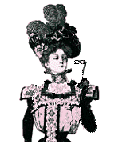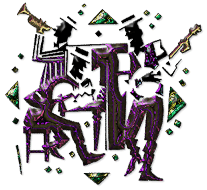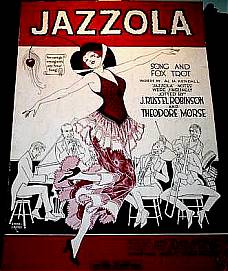
"Does Jazz Put the Sin in Syncopation?"
by Anne Shaw Faulkner, head of the Music
Department of the General Federation of Women's Clubs.
Published in Ladies Home Journal, August 1921, pp. 16-34.
Stop music: SQUARE button.
Play music: ARROW button.

by Anne Shaw Faulkner, head of the Music
Department of the General Federation of Women's Clubs.
Published in Ladies Home Journal, August 1921, pp. 16-34.
We have all been taught to believe that "music soothes the savage breast," but we have never stopped to consider that an entirely different type of music might invoke savage instincts. We have been content to accept all kinds of music, and to admit music in all its phases into our homes, simply because it was music. It is true that frequently father and mother have preferred some old favorite song or dance, or some aria from opera, to the last "best seller" which has found its way into the home circle; but, after all, young people must be entertained and amused, and even if the old-fashioned parents did not enjoy the dance music of the day, they felt it could really do no harm, because it was music.
Therefore, it is somewhat of a rude awakening for many of these parents to find that America is facing a most serious situation regarding its popular music. Welfare workers tell us that never in the history of our land have there been such immoral conditions among our young people, and in the surveys made by many organizations regarding these conditions, the blame is laid on jazz music and its evil influence on the young people of to-day. Never before have such outrageous dances been permitted in private as well as public ballrooms, and never has there been used for the accompaniment of the dance such a strange combination of tone and rhythm as that produced by the dance orchestras of to-day.
Certainly, if this music is in any way responsible for the condition and for the immoral acts which can be traced to the influence of these dances, then it is high time that the question should be raised: "Can music ever be an influence for evil?"

John Held, Jr., "Dancin in the Jazz Age" (1920)
In history there have been several great periods when music was declared to be an evil influence, and certain restrictions were placed upon the dance and the music which accompanied it. But all of these restrictions were made by the clergy, who have never been particularly enthusiastic about dancing anyway. To-day, however, the first great rebellion against jazz music and such dances as the "toddle" and the "shimmy" comes from the dancing masters themselves. Realizing the evil influence of this type of music and dancing, the National Dancing Masters' Association, at their last session, adopted this rule: "Don't permit vulgar cheap jazz music to be played. Such music almost forces dancers to use jerky half-steps, and invites immoral variations. It is useless to expect to find refined dancing when the music lacks all refinement, for, after all, what is dancing but an interpretation of music?"
Several of the large dance halls in the big cities are following the lead of the proprietor of one of them in Chicago, who, when he opened his establishment a few years ago, bravely advertised that no jazz music and no immoral dances would be allowed on his floor. His announcement was met with ridicule, but his dance hall has become the most popular one in Chicago. The place is crowded every evening, and yet nothing except waltzes and two-steps are allowed on the floor and absolutely no jazz music is tolerated.
That jazz is an influence for evil is also felt by a number of the biggest country clubs, which have forbidden the corset check room, the leaving of the hall between dances and the jazz orchestras--three evils which have also been eliminated from many municipal dance halls, particularly when these have been taken under the chaperonage of the Women's Clubs.
Still another proof that jazz is recognized as producing an evil effect is the fact that in almost every big industry where music has been instituted it has been found necessary to discontinue jazz because of its demoralizing effect upon the workers. This was noticed in an unsteadiness and lack of evenness in the workmanship of the product after a period when the workmen had indulged in jazz music.
Many people classify under the title of "jazz" all music in syncopated rhythm, whether it be the ragtime of the American Negro or the csardas of the Slavic people. Yet there is a vast difference between syncopation and jazz. To understand the seriousness of the jazz craze, which, emanating from America, has swept over the world, it is time that the American public should realize what the terms ragtime and jazz mean; for the words are not synonymous, as so many people suppose.
Jazz is not defined in the dictionary or encyclopedia. But Groves' Dictionary of Music says that "ragtime is a modern term of American origin, signifying in the first instance broken rhythm and melody, especially a sort of continuous syncopation." The Encyclopedia Britannica sums up syncopation as "the rhythmic method of tying two beats of the same note into one tone in such a way as to displace the accent." Syncopation, this curious rhythmic accent on the short beat, is found in its most highly developed forms in the music of the folk who have been held for years in political subjection. It is, therefore, an expression in music of the desire for that freedom which has been denied to its interpreter. It is found in its most intense forms among the folk of all the Slavic countries, especially in certain districts of Poland and Russia, and also among the Hungarian gypsies.

For the same reason it was the natural expression of the American Negroes and was used by them as the accompaniment for their bizarre dances and cakewalks. Negro ragtime, it must be frankly acknowledged, is one of the most important and distinctively characteristic American expressions to be found in our native music. Whether ragtime will be the cornerstone of the American School of Music may be a subject for discussion; but the fact remains that many of the greatest compositions by past and present American composers have been influenced by ragtime. Like all other phases of syncopation, ragtime quickens the pulse, it excites, it stimulates; but it does not destroy.
What of jazz? It is hard to define jazz, because it is neither a definite form nor a type of rhythm; it is rather a method employed by the interpreter in playing the dance or song. Familiar hymn tunes can be jazzed until their original melodies are hardly recognizable. Jazz does for harmony what the accented syncopation of ragtime does for rhythm. In ragtime the rhythm is thrown out of joint, as it were, thus distorting the melody; in jazz exactly the same thing is done to the harmony. The melodic line is disjointed and disconnected by the accenting of the partial instead of the simple tone, and the same effect is produced on the melody and harmony which is noticed in syncopated rhythm. The combination of syncopation and the use of these inharmonic partial tones produces a strange, weird effect, which has been designated "jazz."
The jazz orchestra uses only those instruments which can produce partial, inharmonic tones more readily than simple tones--such as the saxophone, the clarinet and the trombone, which share honors with the percussion instruments that accent syncopated rhythm. The combination of the syncopated rhythm, accentuated by the constant use of the partial tones sounding off-pitch, has put syncopation too off-key. Thus the three simple elements of music--rhythm, melody and harmony--have been put out of tune with each other.
Jazz originally was the accompaniment of the voodoo dancer, stimulating the half-crazed barbarian to the vilest deeds. The weird chant, accompanied by the syncopated rhythm of the voodoo invokers, has also been employed by other barbaric people to stimulate brutality and sensuality. That it has a demoralizing effect upon the human brain has been demonstrated by many scientists.
There is always a revolutionary period of the breaking down of old conventions and customs which follows after every great war; and this rebellion against existing conditions is to be noticed in all life to-day. Unrest, the desire to break the shackles of old ideas and forms are abroad. So it is no wonder that young people should have become so imbued with this spirit that they should express it in every phase of their daily lives. The question is whether this tendency should be demonstrated in jazz--that expression of protest against law and order, that bolshevik element of license striving for expression in music.


"Jazzola" by J. Russel Robinson & Theodore Morse (sheet music 1919);
"Parisiola" by Alex Gerber & Abner Silver (sheet music 1920).
The human organism responds to musical vibrations. This fact is universally recognized. What instincts then are aroused by jazz? Certainly not deeds of valor or martial courage, for all marches and patriotic hymns are of regular rhythm and simple harmony; decidedly not contentment or serenity, for the songs of home and the love of native land are all of the simplest melody and harmony with noticeably regular rhythm. Jazz disorganizes all regular laws and order; it stimulates to extreme deeds, to a breaking away from all rules and conventions; it is harmful and dangerous, and its influence is wholly bad.
A number of scientific men who have been working on experiments in musico-therapy with the insane, declare that while regular rhythms and simple tones produce a quieting effect on the brain of even a violent patient, the effect of jazz on the normal brain produces an atrophied condition on the brain cells of conception, until very frequently those under the demoralizing influence of the persistent use of syncopation, combined with inharmonic partial tones, are actually incapable of distinguishing between good and evil, right and wrong.
Such music has become an influence for evil.
Last winter, at one of the biggest high schools in one of our largest cities, a survey was made of the popular songs of the day by the music supervisor, who suggested that a community sing be held for one assembly each week. He requested the students to bring all the popular songs to school that a choice might be made of what to sing. At the end of two weeks he had in his office over two thousand "best sellers." He asked the student body to appoint from among themselves a committee of six to choose the songs to be sung at the assembly. This committee, after going through the two thousand songs, chose forty as being "fit for boys and girls to sing together." With this evil influence surrounding our coming generation, it is not to be wondered at that degeneracy should be developing so rapidly in America.
In a recent letter to the author, Dr. Henry van Dyke says of jazz: "As I understand it, it is not music at all. It is merely an irritation of the nerves of hearing, a sensual teasing of the strings of physical passion. Its fault lies not in syncopation, for that is a legitimate device when sparingly used. But 'jazz' is an unmitigated cacophony, a combination of disagreeable sounds in complicated discords, a willful ugliness and a deliberate vulgarity."
Never in the history of America have we more needed the help and inspiration which good music can and does give. The music department of the General Federation of Women's Clubs has taken for its motto: "To Make Good Music Popular, and Popular Music Good." Let us carry out this motto in every home in America firmly, steadfastly, determinedly, until all the music in our land becomes an influence for good.

Click the REFRESH/RELOAD button (above) to re-play the music.
Related Articles:
Return to Nichols Home Page
Background MIDI: George and Ira Gershwin's "I Got Rhythm"
Source: Jack's "MIDI Music", Jazz Page 3